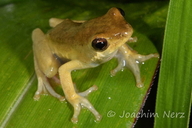|
Hyperolius tuberilinguis Smith, 1849
Tinker Reed Frog, Umgqagqa oluhlaza okotshania (Zulu) | family: Hyperoliidae genus: Hyperolius |
| Species Description: Smith, A. (1849). Illustrations of the Zoology of South Africa; Consisting Chiefly of Figures and Descriptions of the Objects of Natural History Collected during an Expedition into the Interior of South Africa, in the Years 1834, 1835, and 1836 .... Vol. III. Reptilia. Appendix. London: Smith, Elder, & Co. | |
 © 2016 Dr. Joachim Nerz (1 of 18) |
|
|
|
Description Although lacking distinctive characters adult H. tuberilinguis are easily recognisable among the east African lowland fauna by their pointed snout. H. tuberilinguis is quite similar to H. kivuensis, met further inland in eastern Africa, but the latter has a more pointed snout and a conspicuous dark lateral band. There is a great similarity in morphology, voice and "general appearance" between H. concolor, H. balfouri, H. kivuensis and H. tuberilinguis. They can be regarded as members of the same superspecies (Schiøtz 1975). The tadpole reaches a length of up to 46 mm (14+32) with a tooth formula of 1/3. It is brown with golden and bronze spots on the light underside. Distribution and Habitat Country distribution from AmphibiaWeb's database: Kenya, Malawi, Mozambique, South Africa, Swaziland, Tanzania, United Republic of, Zimbabwe
Life History, Abundance, Activity, and Special Behaviors Eggs are white surrounded by a clear jelly, and are placed out of water. Comments This account was taken from "Treefrogs of Africa" by Arne Schiøtz with kind permission from Edition Chimaira publishers, Frankfurt am Main.
References
Phaka, F.M., Netherlands, E.C., Kruger, D.J.D., Du Preez, L.H. (2019). Folk taxonomy and indigenous names for frogs in Zululand, South Africa. J Ethnobiology Ethnomedicine 15, 17. [link] Schiøtz, A. (1999). Treefrogs of Africa. Edition Chimaira, Frankfurt am Main. Originally submitted by: Arne Schiøtz (first posted 2001-01-29) Edited by: Kellie Whittaker (2023-05-31) Species Account Citation: AmphibiaWeb 2023 Hyperolius tuberilinguis: Tinker Reed Frog <https://amphibiaweb.org/species/598> University of California, Berkeley, CA, USA. Accessed Nov 12, 2024.
Feedback or comments about this page.
Citation: AmphibiaWeb. 2024. <https://amphibiaweb.org> University of California, Berkeley, CA, USA. Accessed 12 Nov 2024. AmphibiaWeb's policy on data use. |



 Map of Life
Map of Life